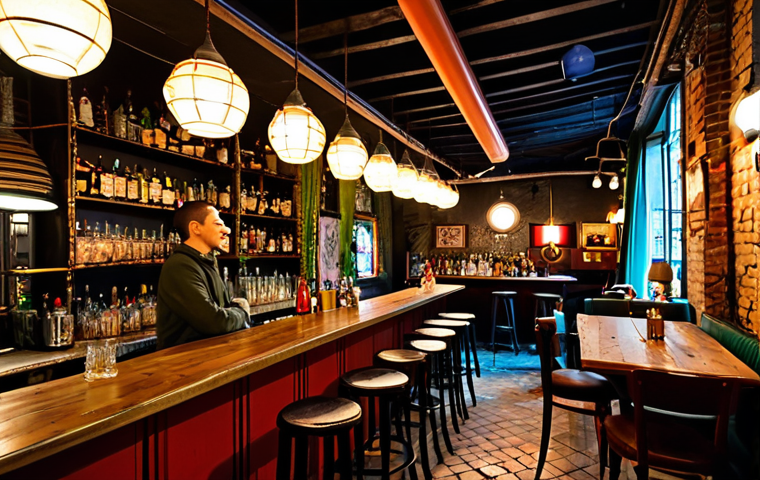Stepping into Budapest’s ruin bars for the first time was like walking into a vibrant, chaotic dream – a feeling I still chase every time I visit. I vividly remember the sheer awe of discovering Szimpla Kert, a place that absolutely redefined what a ‘bar’ could be.
These aren’t just drinking spots; they’re living, breathing art installations, each with its own quirky personality forged from repurposed buildings. In a world where nightlife often feels increasingly homogenized, Budapest’s ruin bars remain fiercely unique, evolving with eclectic events, pop-up markets, and even captivating art exhibitions that go far beyond a simple night out.
They’ve truly become cultural epicenters, attracting not just party-goers but anyone seeking an authentic slice of the city’s vibrant, creative soul. Given their incredible resilience and adaptability, it’s fascinating to ponder how these spaces will continue to push the boundaries of urban entertainment, perhaps even integrating more sustainable practices or immersive digital art installations in the years to come, ensuring their unique charm endures.
Let’s dive into the details below.
Stepping into Budapest’s ruin bars for the first time was like walking into a vibrant, chaotic dream – a feeling I still chase every time I visit. I vividly remember the sheer awe of discovering Szimpla Kert, a place that absolutely redefined what a ‘bar’ could be.
These aren’t just drinking spots; they’re living, breathing art installations, each with its own quirky personality forged from repurposed buildings. In a world where nightlife often feels increasingly homogenized, Budapest’s ruin bars remain fiercely unique, evolving with eclectic events, pop-up markets, and even captivating art exhibitions that go far beyond a simple night out.
They’ve truly become cultural epicenters, attracting not just party-goers but anyone seeking an authentic slice of the city’s vibrant, creative soul. Given their incredible resilience and adaptability, it’s fascinating to ponder how these spaces will continue to push the boundaries of urban entertainment, perhaps even integrating more sustainable practices or immersive digital art installations in the years to come, ensuring their unique charm endures.
Let’s dive into the details below.
The Genesis of Grandeur: From Rubble to Revelry

When I first heard about “ruin bars,” my imagination conjured images of dilapidated buildings serving cheap drinks, but the reality was so much more profound and utterly captivating.
These weren’t simply abandoned spaces reanimated; they were meticulously, yet organically, transformed with an almost punk-rock ingenuity that defies conventional design.
I remember standing in the sprawling courtyard of Szimpla Kert, my jaw practically on the floor, mesmerized by the layers of graffiti, mismatched furniture, and the sheer audacity of it all.
It felt like walking through a living art project, a defiant celebration of creativity born from urban decay. This transformative process wasn’t just about opening a new bar; it was about reclaiming forgotten spaces and imbuing them with a new kind of life, a distinctly Budapestian spirit that cherishes the unconventional and celebrates collective experience.
The sheer scale and intricate details within each bar tell a story of ingenuity, resourcefulness, and a deep-seated desire to create something truly unique that couldn’t possibly exist anywhere else in the world, a testament to the city’s artistic resilience and vibrant underground culture.
Embracing the Imperfect Aesthetic
The beauty of a ruin bar lies precisely in its imperfections. Every worn brick, every peeling poster, every piece of salvaged furniture tells a story, creating an atmosphere that feels both deeply authentic and incredibly intimate.
I recall finding a cozy nook in Fogas Ház, nestled on an old, slightly wobbly armchair that probably had seen decades of life before finding its home there.
This “found object” aesthetic isn’t an accident; it’s a deliberate artistic choice that lends a soulfulness you simply won’t find in a sterile, purpose-built club.
It’s an embrace of the city’s past, a tangible connection to its history, reinterpreted through a modern, vibrant lens. This unique blend of history and contemporary art provides an unparalleled backdrop for social interaction, making every corner a potential discovery and every conversation feel part of something bigger, a shared experience within a truly singular environment.
The Social Heartbeat of a City
More than just places to grab a drink, these establishments quickly became vital social hubs. They weren’t just for tourists; locals embraced them as communal living rooms, spaces where diverse groups could mingle, ideas could spark, and friendships could form.
I’ve personally witnessed impromptu jam sessions, passionate debates, and strangers sharing travel stories over a pint of local craft beer. This organic fusion of culture and community is perhaps their greatest legacy, providing a much-needed antidote to the often isolated nature of modern urban life.
The very structure of these bars, with their sprawling courtyards and multiple themed rooms, encourages exploration and interaction, breaking down traditional social barriers and fostering a genuine sense of belonging among patrons from all walks of life, reflecting the city’s open and welcoming spirit.
A Tapestry of Taste and Sound: Sensory Immersion
My first foray into Budapest’s ruin bars was an absolute feast for the senses, a kaleidoscopic explosion of sights, sounds, and unexpected delights. Each bar offered a distinct auditory and visual landscape, from the eclectic playlists that bounced between indie rock and Hungarian folk music to the dazzling, often surreal art installations that adorned every available surface.
I vividly remember the aroma of street food mingling with the faint scent of hops and damp earth at Szimpla Kert’s food court, a truly unique olfactory signature that perfectly encapsulated the venue’s bohemian charm.
It wasn’t just about drinking; it was about experiencing a living, breathing, multisensory environment that continuously evolved and surprised you, making every visit a fresh adventure.
The curated chaos of the decor, combined with the diverse music and the general buzz of conversation, creates an atmosphere that is both incredibly stimulating and profoundly immersive, drawing you deeper into its unique world.
Culinary Adventures Beyond the Pint
Many ruin bars have evolved into surprising culinary destinations, offering far more than just standard bar snacks. My personal favorite discovery was the incredible variety of street food available within Szimpla Kert’s courtyard, from delicious lángos – a traditional Hungarian fried bread – topped with sour cream and cheese, to gourmet burgers and artisanal pizzas.
It’s not just convenient; it adds another layer to the experience, transforming a simple night out into a full-fledged gastronomic exploration. I’ve spent entire evenings just grazing from different stalls, pairing each bite with a local wine or pálinka, and truly feeling like I was part of a vibrant, evolving food scene.
This integration of diverse culinary offerings caters to a wider audience, ensuring that the ruin bars are not just about drinks, but about a comprehensive cultural and social experience that tantalizes every palate.
The Soundscapes of Eclectic Nights
The music in Budapest’s ruin bars is as varied and unpredictable as their decor, a true reflection of the city’s diverse artistic scene. I’ve danced to everything from live jazz bands to pulsating techno sets, and even stumbled upon a silent disco in a hidden corner.
Many bars feature multiple rooms, each with a different vibe and genre of music, allowing you to curate your own auditory journey throughout the night.
It’s this commitment to musical diversity that sets them apart, ensuring that there’s always something to suit every taste, whether you’re into electronic beats or more laid-back acoustic sessions.
The curated soundscapes are integral to the unique atmosphere, transforming each space into a dynamic stage for local and international talent, and providing a continuous stream of fresh auditory experiences that keep patrons engaged and entertained.
Navigating the Labyrinth: Finding Your Perfect Haunt
The sheer number and variety of ruin bars in Budapest can be a bit overwhelming for a first-timer, and I remember feeling a thrilling sense of exploration, like an urban Indiana Jones, trying to uncover their hidden treasures.
Each bar has its own distinct personality, catering to different moods and preferences, which means a little bit of exploration and knowing what you’re looking for can make all the difference in finding your perfect spot.
My advice is always to embrace the journey, allowing yourself to get wonderfully lost in the city’s inner courtyards and unexpected alleyways. It’s part of the authentic experience.
Don’t be afraid to poke your head into places that seem unassuming from the street; often, the most incredible discoveries are hidden behind modest facades, waiting to reveal their vibrant interiors and unique charms.
Beyond Szimpla: Discovering Hidden Gems
While Szimpla Kert is undeniably the grand dame of ruin bars, a must-visit for its iconic status and sheer scale, don’t limit yourself to just one experience.
I’ve found immense joy in exploring lesser-known spots, like the artsy confines of Instant-Fogas, which boasts multiple dance floors and a truly labyrinthine layout, or the quirky charm of Ankert, with its more open-air feel.
Each offers a subtly different vibe, from underground techno dens to more relaxed garden settings perfect for conversation. My strategy has always been to pick one famous one, then spend an evening wandering the Jewish Quarter, letting curiosity guide me into whatever intriguing doorway presents itself.
You’ll be amazed at the diverse ecosystems of fun and creativity that exist just a few blocks from each other, each with its own story to tell and a distinct atmosphere to immerse yourself in.
Practical Tips for the First-Timer
For anyone venturing into the ruin bar scene for the first time, a few practical pointers can significantly enhance your experience. Firstly, go early if you want to truly appreciate the decor and find a good spot; they can get incredibly crowded, especially on weekends.
Secondly, embrace the cash-only policy that some smaller establishments still have, though most major ones now accept cards. Lastly, don’t be afraid to explore every nook and cranny; these bars are designed to be discovered, with hidden rooms, secret staircases, and unexpected art installations around every corner.
Staying aware of your belongings, especially in crowded areas, is always wise, just as it would be in any bustling city nightlife scene. Locals are generally friendly, so don’t hesitate to ask for recommendations or directions if you’re feeling a little lost in the maze.
The Unseen Impact: Cultural Catalyst and Urban Regeneration
It’s easy to get lost in the vibrant energy and unique aesthetic of Budapest’s ruin bars, but their impact extends far beyond just providing a great night out.
From my perspective, having watched the city evolve over several visits, these bars have played a profound and often underestimated role in the revitalization of entire neighborhoods, particularly the Jewish Quarter.
They didn’t just fill empty buildings; they breathed new life into an area that was once neglected, transforming it into one of Europe’s most dynamic cultural and entertainment hubs.
This wasn’t a top-down urban planning initiative; it was an organic, grassroots movement that demonstrated the power of creative entrepreneurship and community spirit to spark widespread regeneration and attract a new wave of visitors and businesses to the area, fundamentally changing its economic and social landscape.
Spurring Economic Vibrancy
The success of the ruin bars created a ripple effect throughout the local economy. Suddenly, areas that had seen little investment were teeming with foot traffic, leading to the opening of new restaurants, boutique shops, and guesthouses.
I’ve seen countless small businesses flourish in the shadow of these nightlife giants, all benefiting from the increased tourism and local interest they generated.
This economic boom wasn’t just about large-scale developments; it significantly benefited local entrepreneurs and artists, providing them with platforms and opportunities they might not have had otherwise.
The demand for local services, from taxi drivers to street food vendors, surged, creating a robust micro-economy that supported a wide array of Budapest residents, illustrating how cultural innovations can drive tangible economic benefits for an entire community.
A Hub for Arts and Innovation
Beyond their role as bars, these venues quickly became vital incubators for the arts, providing much-needed spaces for local artists, musicians, and performers to showcase their talents.
I’ve attended everything from independent film screenings and art exhibitions to craft markets and poetry slams within these unconventional settings. This commitment to supporting local creatives is a core part of their identity and contributes significantly to the city’s rich cultural tapestry.
They serve as a constant reminder that art doesn’t need to be confined to traditional galleries; it thrives in unexpected places, reaching diverse audiences and fostering a spirit of continuous innovation and artistic experimentation that keeps Budapest’s creative scene fresh and exciting, constantly pushing boundaries and embracing new forms of expression.
| Ruin Bar | Vibe/Specialty | Best For | Typical Entry Fee |
|---|---|---|---|
| Szimpla Kert | Iconic, eclectic, multi-room, cultural hub | First-timers, large groups, experiencing the original concept, Sunday farmers market | Free (events may vary) |
| Instant-Fogas Complex | Massive, multi-dancefloor, club-like atmosphere, labyrinthine | Dancing, late-night partying, diverse music tastes | Free (special events may vary) |
| Ankert | Open-air courtyard, laid-back, summer vibes, occasional events | Summer evenings, relaxed drinks, more spacious feel | Free (events may vary) |
| Doboz | Stylish, modern art, sometimes more mainstream music, often a bit more upscale | Trendy nights out, those seeking a slightly more polished ruin bar | Free (special events may vary) |
The Future of Chaos: Evolution and Enduring Charm
Having witnessed the incredible evolution of Budapest’s ruin bars over the years, I’m continually fascinated by their ability to adapt and redefine themselves, proving that true innovation doesn’t stand still.
What started as a counter-cultural movement has blossomed into a global phenomenon, yet somehow, many of these places have managed to retain their authentic, rebellious spirit while catering to an ever-growing influx of visitors.
It’s a delicate balance to strike, preserving the original ethos while embracing necessary changes, but the most successful ruin bars seem to have mastered this art.
My hope, and indeed my expectation, is that they will continue to push the boundaries of what a hospitality venue can be, remaining at the forefront of urban entertainment innovation and cultural integration, proving that sustainability isn’t just about eco-friendly practices but also about the longevity of unique, community-driven spaces.
Adapting to a Changing Landscape
The landscape of Budapest’s nightlife is constantly shifting, with new trends emerging and tourist preferences evolving. What I’ve observed is the ruin bars’ remarkable capacity to adapt without losing their core identity.
They’ve integrated diverse music genres, embraced pop-up culinary experiences, and even hosted wellness events, demonstrating a flexibility that most traditional venues simply can’t match.
This adaptability ensures their continued relevance and appeal, allowing them to remain dynamic and exciting, rather than becoming static relics of a bygone era.
It’s a testament to the foresight and creativity of their owners and operators, who consistently find new ways to engage their audience and keep the experience fresh, ensuring that the ruin bars remain vital components of the city’s vibrant cultural tapestry for years to come.
Sustainable Practices and Community Focus
As global awareness around sustainability grows, I’ve started noticing a subtle but significant shift towards more environmentally conscious practices within some of the ruin bars.
Given their origins in repurposing and recycling, it feels like a natural progression. From sourcing local ingredients for their food stalls to implementing waste reduction programs and even using energy-efficient lighting, there’s a growing emphasis on minimizing their environmental footprint.
This commitment to sustainability, coupled with their inherent focus on community engagement and supporting local artists, reinforces their role not just as entertainment venues, but as responsible and forward-thinking cultural institutions that actively contribute to the well-being of the city and its inhabitants, securing their unique place in Budapest’s future.
Closing Thoughts
Stepping out of a Budapest ruin bar, you don’t just leave a drinking establishment; you depart from a living, breathing piece of art, a cultural hub that defies easy categorization. My countless evenings spent within their quirky walls have left me with far more than just hazy memories; they’ve imbued me with a deep appreciation for the city’s unique spirit of resilience, creativity, and community. These aren’t just bars; they are dynamic canvases of urban regeneration, constantly evolving, yet steadfast in their commitment to providing unforgettable experiences that are authentically Budapestian.
Useful Information to Know
1. Payment Methods: While many larger ruin bars now accept credit cards, it’s always wise to carry some Hungarian Forint (HUF) for smaller purchases, local street food vendors within the bars, or smaller, less-known establishments. Cash is king in some hidden gems!
2. Best Time to Visit: If you want to appreciate the intricate decor and find a good spot without feeling overwhelmed, aim to go early in the evening, perhaps between 6 PM and 8 PM. For a bustling, high-energy party atmosphere, Friday and Saturday nights from 10 PM onwards are when they truly come alive.
3. Transportation: Budapest has an excellent public transport system (metro, trams, buses), but many ruin bars are concentrated in the Jewish Quarter, making them easily walkable from many central accommodations. Taxis and ride-sharing services are also readily available, especially late at night.
4. Safety & Belongings: Like any popular nightlife spot globally, it’s important to be aware of your surroundings and keep an eye on your belongings. While generally safe, crowded areas can sometimes attract pickpockets. Stick with friends and drink responsibly.
5. Exploring Beyond the Mainstream: While Szimpla Kert and Instant-Fogas are iconic, don’t be afraid to wander into other establishments that catch your eye. Budapest’s ruin bar scene is constantly evolving, and some of the most memorable experiences can be found in the smaller, less-advertised venues.
Key Takeaways
Budapest’s ruin bars are more than just venues for a night out; they are unique cultural phenomena born from urban regeneration and artistic ingenuity.
They offer an immersive, multi-sensory experience through their eclectic decor, diverse music, and surprising culinary offerings. These establishments serve as vital social and artistic hubs, fostering community and supporting local creatives.
To truly experience them, embrace exploration, carry some local currency, and immerse yourself in their ever-evolving, chaotic charm.
Frequently Asked Questions (FAQ) 📖
Q: What’s the real ‘vibe’ of a Budapest ruin bar, especially if you’re expecting just another typical bar?
A: Oh, trust me, you’re in for a total shock – and the best kind! Stepping into a ruin bar, like the very first time I walked into Szimpla Kert, it’s not just a bar; it’s an entire universe.
Imagine forgotten buildings resurrected into a labyrinth of art, mismatched furniture, and quirky installations at every turn. It feels less like a venue and more like someone’s outrageously creative, sprawling living room, bursting with stories.
The air practically hums with a vibrant, chaotic energy that’s completely unique; you won’t find that cookie-cutter, homogenous vibe here. It truly redefines what a ‘night out’ can even be.
Q: Beyond just drinking, what else can visitors genuinely experience at these ruin bars?
A: Honestly, to call them just “drinking spots” would be missing the entire point! From my own visits, I’ve seen them transform into so much more. They’re cultural melting pots.
One night you might stumble upon a pop-up artisan market – I’ve bought some really cool, unique art pieces there – and the next, it’s hosting an independent film screening or a live music jam session that just blew me away.
They champion local artists with ever-changing exhibitions, and you’ll find all sorts of folks, not just the usual party crowd, soaking it all in. It’s about tapping into the city’s living, breathing creative soul, not just grabbing a pint.
Q: Given their unique resilience, how do you see Budapest’s ruin bars evolving or staying relevant in the years to come?
A: That’s the million-dollar question, isn’t it? What absolutely fascinates me about these places is their incredible knack for reinvention. They’ve already defied expectations by enduring and thriving.
I truly believe their adaptability will keep them pushing boundaries. I can totally imagine them diving deeper into sustainable practices – think more upcycled materials, maybe even rooftop urban gardens integrated right into the space.
And with technology, why not immersive digital art installations that truly blend the old-world charm with cutting-edge experiences? They’ll continue to evolve, I’m sure, but always with that fiercely unique, authentic spirit that makes them so special.
That’s the magic I hope they never lose.
📚 References
Wikipedia Encyclopedia
구글 검색 결과
구글 검색 결과
구글 검색 결과
구글 검색 결과
구글 검색 결과




